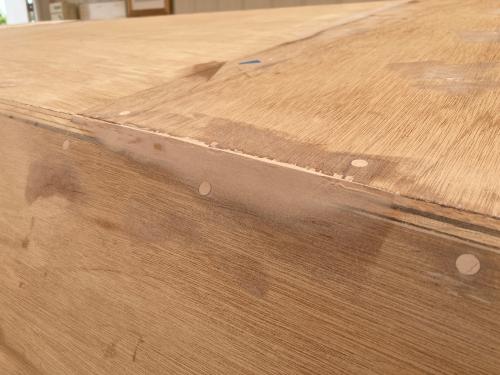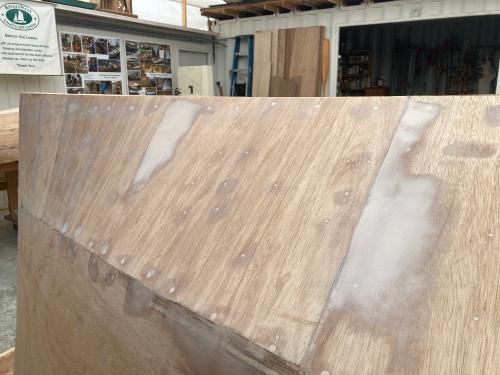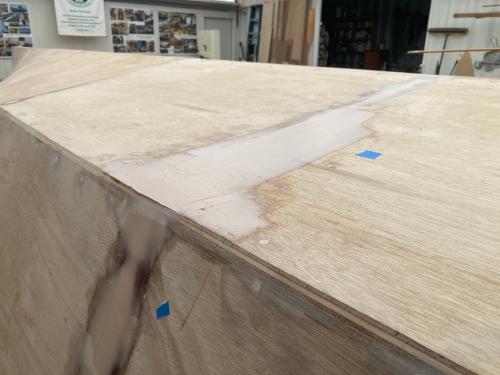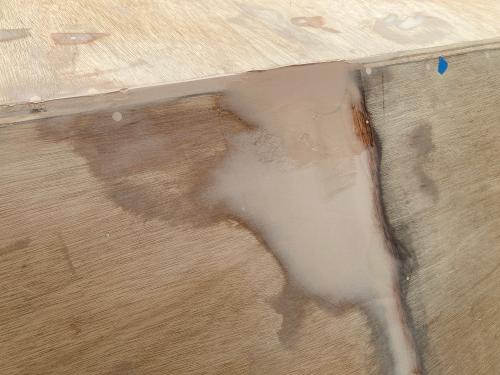Re: Point Comfort 23
Posted by MarkR on
URL: http://riverswest-forums.266.s1.nabble.com/Point-Comfort-23-tp527p565.html
Fairing is a lot of work, but it's what's needed to produce a fair hull. Inevitably some 'waggle' is built into every hull. It can be minor and usually is. The prescription for painted hulls is fairing.

Basically, fairing compound is used in a similar fashion as bondo in body repair. It fills in the low spots. On this hull, there were some areas that were in need of fairing due to the design. The forefoot of this boat is made of multiple cross planked layers to form a very shapely boat. On a traditionally built, solid planked boat, this would mean planing and sanding to a fair shape. Unfortunately, plywood only twists so far, so some fairing and shaping is required.

Then there was one instance where the scarf wasn't quite 'perfect'. All of you who haven't made a perfect scarf, please raise your hand. If you haven't tried a scarf, then your time is coming. Scarfs are one of the parts of boat building that preserve your humble nature. The imperfect scarf is getting fixed now.

Next, on the forward topsides, I managed to get a misalignment in the butt joints between panels. Probably an overplaning of the butt block.

Again, a bit of fairing compound, a lot of sweat on the longboards and some ROS work for the big lumps take care of it.
A note on longboarding: First, this is not a skateboard. It's a long sanding board that is used to identify and remove high spots in the hull. Once the high spots are identified, the fairing compound can be applied. In our case, the fairing compound we are working with is System 3's QuickFair. It's easily mixed, applies and adheres well and cures quickly. When you start to sand, make sure you wear your dust mask to protect from uncured epoxy dust.
Fairing is a process. Go slowly and 'sneak up' on the final result. Heavy applications of fairing compounds in warm temperatures lead to bubbles that then need to be filled. So take your time, be patient and get the result that you really want. This is where you begin to establish your quality of finish. I'll write more about priorities of finished product later. All for now, see you later...We're going to do the final prep for fiberglass and epoxy!
URL: http://riverswest-forums.266.s1.nabble.com/Point-Comfort-23-tp527p565.html
Fairing is a lot of work, but it's what's needed to produce a fair hull. Inevitably some 'waggle' is built into every hull. It can be minor and usually is. The prescription for painted hulls is fairing.

Basically, fairing compound is used in a similar fashion as bondo in body repair. It fills in the low spots. On this hull, there were some areas that were in need of fairing due to the design. The forefoot of this boat is made of multiple cross planked layers to form a very shapely boat. On a traditionally built, solid planked boat, this would mean planing and sanding to a fair shape. Unfortunately, plywood only twists so far, so some fairing and shaping is required.

Then there was one instance where the scarf wasn't quite 'perfect'. All of you who haven't made a perfect scarf, please raise your hand. If you haven't tried a scarf, then your time is coming. Scarfs are one of the parts of boat building that preserve your humble nature. The imperfect scarf is getting fixed now.

Next, on the forward topsides, I managed to get a misalignment in the butt joints between panels. Probably an overplaning of the butt block.

Again, a bit of fairing compound, a lot of sweat on the longboards and some ROS work for the big lumps take care of it.
A note on longboarding: First, this is not a skateboard. It's a long sanding board that is used to identify and remove high spots in the hull. Once the high spots are identified, the fairing compound can be applied. In our case, the fairing compound we are working with is System 3's QuickFair. It's easily mixed, applies and adheres well and cures quickly. When you start to sand, make sure you wear your dust mask to protect from uncured epoxy dust.
Fairing is a process. Go slowly and 'sneak up' on the final result. Heavy applications of fairing compounds in warm temperatures lead to bubbles that then need to be filled. So take your time, be patient and get the result that you really want. This is where you begin to establish your quality of finish. I'll write more about priorities of finished product later. All for now, see you later...We're going to do the final prep for fiberglass and epoxy!
| Free forum by Nabble | Edit this page |